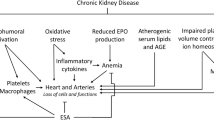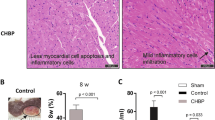Abstract
Purpose
Erythropoietin (EPO) and its non-erythrogenic derivative, carbarmylated EPO (CEPO), have been reported to activate different receptors (homomeric EPO receptor vs. heteromeric receptor consisting of EPO receptor monomer and common β-subunit). The aim of this study was to examine differences between EPO and CEPO in efficacy of cardioprotection against infarction and in activation of pro-survival kinases.
Methods
In isolated rat hearts, infarction was induced by global ischemia followed by reperfusion. Infarct size was determined 2 h after reperfusion, and ventricular tissues for immunoblotting were sampled at 5 min after reperfusion.
Results
Pretreatment with EPO (10 units/ml) before ischemia reduced infarct size (% of risk area; %IS/AR) from 47.0 ± 2.1% of the control after 20-min ischemia to 24.7 ± 4.3% and from 62.0 ± 3.0% after 25-min ischemia to 45.5 ± 4.1%. Desialylated EPO (asialoEPO, 100 ng/ml) mimicked the protection by EPO. However, CEPO (100 ng/ml) failed to reduce infarct size after 20-min ischemia (%IS/AR = 47.5 ± 5.9%) and that after 25-min ischemia (%IS/AR = 56.1 ± 4.2%). The infarct size-limiting effect of CEPO was not shown either by increasing CEPO dose to 500 ng/ml or by shortening ischemia to 15 min. Both EPO and CEPO enhanced phosphorylation of cytosolic GSK-3β upon reperfusion. In contrast, phosphorylation of GSK-3β, Akt, and PKC-ε in mitochondria upon reperfusion was significantly enhanced by EPO but not by CEPO.
Conclusion
EPO affords more potent protection against infarction than does CEPO by distinct activation of signaling leading to phosphorylation of pro-survival protein kinases in mitochondria upon reperfusion.







Similar content being viewed by others
References
Joyeux-Faure M. Cellular protection by erythropoietin: new therapeutic implications? J Pharmacol Exp Ther. 2007;323:759–62.
Ruifrok WP, de Boer RA, Westenbrink BD, van Veldhuisen DJ, van Gilst WH. Erythropoietin in cardiac disease: new features of an old drug. Eur J Pharmacol. 2008;585:270–7.
Jubinsky PT, Krijanovski OI, Nathan DG, Tavernier J, Sieff CA. The β chain of the interleukin-3 receptor functionally associates with the erythropoietin receptor. Blood. 1997;90:1867–73.
Chin H, Wakao H, Miyajima A, Kamiyama R, Miyasaka N, Miura O. Erythropoietin induces tyrosine phosphorylation of the interleukin-3 receptor β subunit (βIL3) and recruitment of Stat5 to possible Stat5-dokcing sites in βIL3. Blood. 1997;89:4327–36.
D’Andrea RJ, Gonda TJ. A model for assembly and activation of the GM-CSF, IL-3 and IL-5 receptors: insights from activated mutants of the common beta subunit. Exp Hematol. 2000;28:231–43.
Fiordaliso F, Chimenti S, Staszewsky L, Bai A, Carlo E, Cuccovillo I, et al. A nonerythropoietic derivative of erythropoietin protects the myocardium from ischemia-reperfusion injury. Proc Natl Acad Sci U S A. 2005;102:2046–51.
Leist M, Ghezzi P, Grasso G, Bianchi R, Villa P, Fratelli M, et al. Derivatives of erythropoietin that are tissue protective but not erythropoietic. Science. 2004;305:239–42.
Sinclair AM, Coxon A, McCaffery I, Kaufman S, Paweletz K, Liu L, et al. Functional erythropoietin receptor is undetectable in endothelial, cardiac, neuronal, and renal cells. Blood. 2010;115:4264–72.
Um M, Gross AW, Lodish HF. A “classical” homodimeric erythropoietin receptor is essential for the antiapoptotic effects of erythropoietin on differentiated neuroblastoma SH-SY5Y and pheochromocytome PC-12 cells. Cell Signal. 2007;19:634–45.
Kanellakis P, Pomilio K, Agrotis A, Gao X, Du XJ, Bobik A. Darbepoietin-mediated cardioprotection after myocardial infarction involves multiple mechanisms independent of erythropoietin receptor-common beta-chain heteroreceptor. Br J Pharmacol. 2010;160:2085–96.
Hausenloy DJ, Yellon DM. Reperfusion injury salvage kinase signalling: taking a RISK for cardioprotection. Heart Fail Rev. 2007;12:217–34.
Juhaszova M, Zorov DB, Kim SH, Pepe S, Fu Q, Fishbein KW, et al. Glycogen synthase kinase-3β mediates convergence of protection signaling to inhibit the mitochondrial permeability transition pore. J Clin Invest. 2004;113:1535–49.
Nishihara M, Miura T, Miki T, Tanno M, Yano T, Naitoh K, et al. Modulation of the mitochondrial permeability transition pore complex in GSK-3beta-mediated myocardial protection. J Mol Cell Cardiol. 2007;43:564–70.
Ohori K, Miura T, Tanno M, Miki T, Sato T, Ishikawa S, et al. Ser9 phosphorylation of mitochondrial GSK-3beta is a primary mechanism of cardiomyocyte protection by erythropoietin against oxidant-induced apoptosis. Am J Physiol Heart Circ Physiol. 2008;295:H2079–86.
Nishihara M, Miura T, Miki T, Sakamoto J, Tanno M, Kobayashi H, et al. Erythropoietin affords additional cardioprotection to preconditioned hearts by enhanced phosphorylation of glycogen synthase kinase-3 beta. Am J Physiol Heart Circ Physiol. 2006;291:H748–55.
Kobayashi H, Miura T, Ishida H, Miki T, Tanno M, Yano T, et al. Limitation of infarct size by erythropoietin is associated with translocation of Akt to the mitochondria after reperfusion. Clin Exp Pharmacol Physiol. 2008;35:812–9.
Juhaszova M, Zorov DB, Yaniv Y, Nuss HB, Wang S, Sollott SJ. Role of glycogen synthase kinase-3beta in cardioprotection. Circ Res. 2009;104:1240–52.
Miura T, Miki T. GSK-3beta, a therapeutic target for cardiomyocyte protection. Circ J. 2009;73:1184–92.
Miki T, Miura T, Tanno M, Nishihara M, Naitoh K, Sato T, et al. Impairment of cardioprotective PI3K-Akt signaling by post-infarct ventricular remodeling is compensated by an ERK-mediated pathway. Basic Res Cardiol. 2007;102:163–70.
Miura T, Yano T, Naitoh K, Nishihara M, Miki T, Tanno M, et al. Delta-opioid receptor activation before ischemia reduces gap junction permeability in ischemic myocardium by PKC-epsilon-mediated phosphorylation of connexin 43. Am J Physiol Heart Circ Physiol. 2007;293:H1425–31.
Erbayraktar S, Grasso G, Sfacteria A, Xie QW, Coleman T, Kreilgaard M, et al. Asialoerythropoietin is a nonerythropoietic cytokine with broad neuroprotective activity in vivo. Proc Natl Acad Sci U S A. 2003;100:6741–6.
Moon C, Krawczyk M, Paik D, Coleman T, Brines M, Juhaszova M, et al. Erythropoietin, modified to not stimulate red blood cell production, retains its cardioprotective properties. J Pharmacol Exp Ther. 2006;316:999–1005.
Xu X, Cao Z, Cao B, Li J, Guo L, Que L, et al. Carbamylated erythropoietin protects the myocardium from acute ischemia/reperfusion injury through a PI3K/Akt-dependent mechanism. Surgery. 2009;146:506–14.
Ramirez R, Carracedo J, Nogueras S, Buendia P, Merino A, Cañadillas S, et al. Carbamylated darbepoetin derivative prevents endothelial progenitor cell damage with no effect on angiogenesis. J Mol Cell Cardiol. 2009;47:781–8.
Hausenloy DJ, Tsang A, Mocanu MM, Yellon DM. Ischemic preconditioning protects by activating prosurvival kinases at reperfusion. Am J Physiol Heart Circ Physiol. 2005;288:H971–6.
Yang XM, Proctor JB, Cui L, Krieg T, Downey JM, Cohen MV. Multiple, brief coronary occlusions during early reperfusion protect rabbit hearts by targeting cell signaling pathways. J Am Coll Cardiol. 2004;44:1103–10.
Downey JM, Davis AM, Cohen MV. Signaling pathways in ischemic preconditioning. Heart Fail Rev. 2007;12:181–8.
Hausenloy DJ, Ong SB, Yellon DM. The mitochondrial permeability transition pore as a target for preconditioning and postconditioning. Basic Res Cardiol. 2009;104:189–202.
Gomez L, Paillard M, Thibault H, Derumeaux G, Ovize M. Inhibition of GSK3beta by postconditioning is required to prevent opening of the mitochondrial permeability transition pore during reperfusion. Circulation. 2008;117:2761–8.
Bullard AJ, Yellon DM. Chronic erythropoietin treatment limits infarct-size in the myocardium in vitro. Cardiovasc Drugs Ther. 2005;19:333–6.
Baker JE, Kozik D, Hsu AK, Fu X, Tweddell JS, Gross GJ. Darbepoetin alfa protects the rat heart against infarction: dose-response, phase of action, and mechanisms. J Cardiovasc Pharmacol. 2007;49:337–45.
Baines CP, Zhang J, Wang GW, Zheng YT, Xiu JX, Cardwell EM, et al. Mitochondrial PKCε and MAPK form signaling modules in the murine heart. Enhanced mitochondrial PKCε-MAPK interactions and differential MAPK activation in PKCε-induced cardioprotection. Circ Res. 2002;90:390–7.
Baines CP, Song CX, Zheng YT, Wang GW, Zhang J, Wang OL, et al. Protein kinase Cε interacts with and inhibits the permeability transition pore in cardiac mitochondria. Circ Res. 2003;92:873–80.
Rasola A, Sciacovelli M, Chiara F, Pantic B, Brusilow WS, Bernardi P. Activation of mitochondrial ERK protects cancer cells from death through inhibition of the permeability transition. Proc Natl Acad Sci. 2010;107:726–31.
Miki T, Miura T, Hotta H, Tanno M, Yano T, Sato T, et al. Endoplasmic reticulum stress in diabetic hearts abolishes erythropoietin-induced myocardial protection by impairment of phospho-glycogen synthase kinase-3beta-mediated suppression of mitochondrial permeability transition. Diabetes. 2009;58:2863–72.
Zorov DB, Juhaszova M, Yaniv Y, Nuss HB, Wang S, Sollott SJ. Regulation and pharmacology of the mitochondrial permeability transition pore. Cardiovasc Res. 2009;83:213–25.
Sun L, Shurkair S, Naik TJ, Moazed F, Ardehali H. Glucose phophorylation and mitochondrial binding are required for the protective effects of hexokinases I and II. Mol Cell Biol. 2008;28:1007–17.
Costa ADT, Garlid KD. Intramitochondrial signaling: interactions among mitoKATP, PKCε, ROS, and MPT. Am J Physiol Heart Circ Physiol. 2008;295:H879–82.
Costa AD, Garlid KD, West IC, Lincoln TM, Downey JM, Cohen MV, et al. Protein kinase G transmits the cardioprotective signal from cytosol to mitochondria. Circ Res. 2005;97:329–36.
Nishino Y, Webb IG, Davidson SM, Ahmed AI, Clark JE, Jacquet S, et al. Glycogen synthase kinase-3 inactivation is not required for ischemic preconditioning or postconditioning in the mouse. Circ Res. 2008;103:307–14.
Skyschally A, van Caster P, Boengler K, Gres P, Musiolik J, Schilawa D, et al. Ischemic postconditioning in pigs: no causal role for RISK activation. Circ Res. 2009;104:15–8.
Acknowledgement
This study was supported by Japanese Society for the Promotion of Science Grants-in-Aid for Scientific Research (20590870), Tokyo, Japan and by a research grant from Chugai Pharmaceutical Co., Ltd, Tokyo, Japan.
Author information
Authors and Affiliations
Corresponding author
Rights and permissions
About this article
Cite this article
Sato, T., Tanno, M., Miki, T. et al. Erythropoietin (EPO) Affords More Potent Cardioprotection by Activation of Distinct Signaling to Mitochondrial Kinases Compared with Carbamylated EPO. Cardiovasc Drugs Ther 24, 401–408 (2010). https://doi.org/10.1007/s10557-010-6265-5
Published:
Issue Date:
DOI: https://doi.org/10.1007/s10557-010-6265-5




